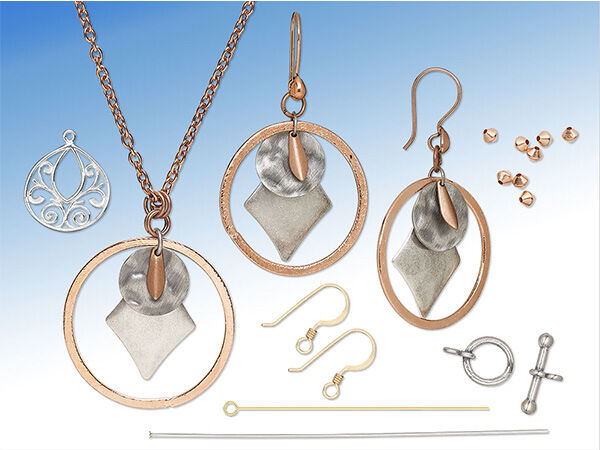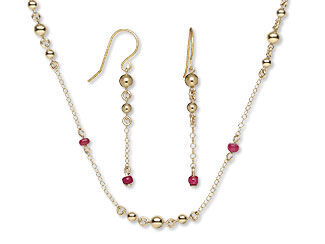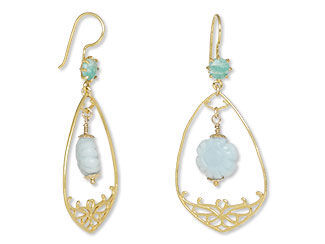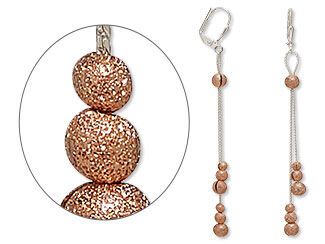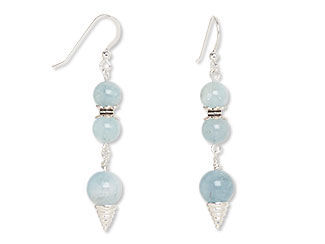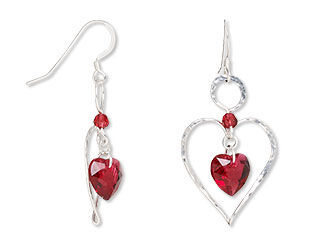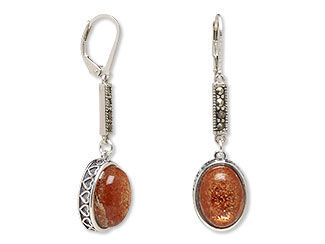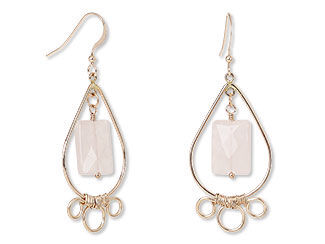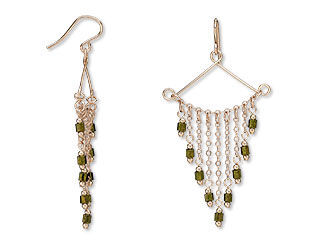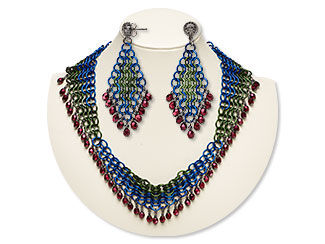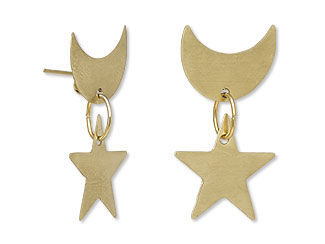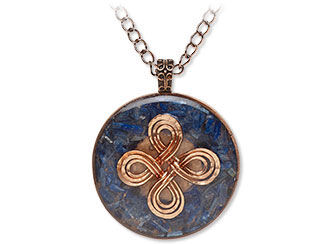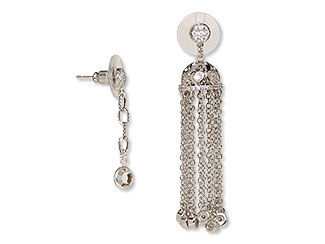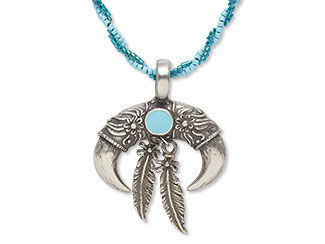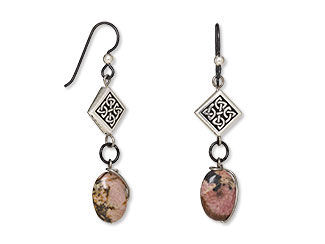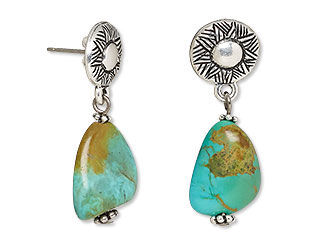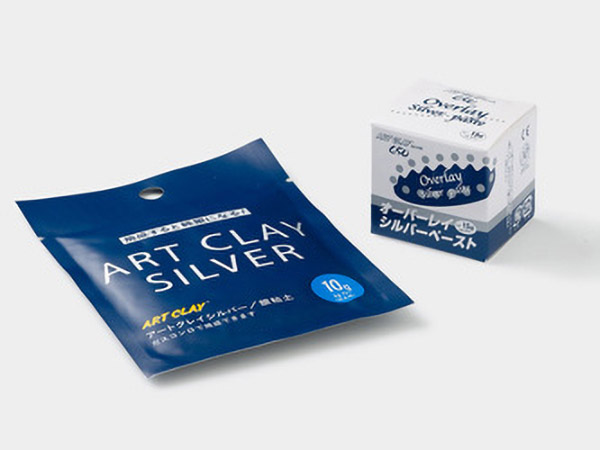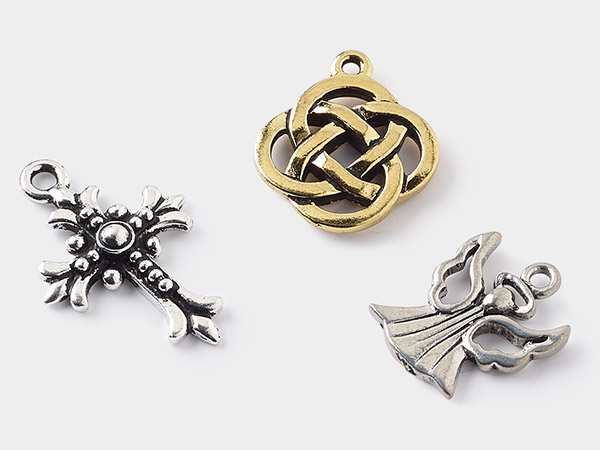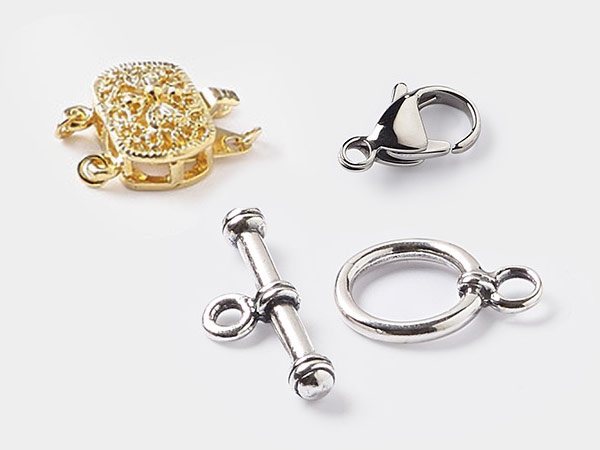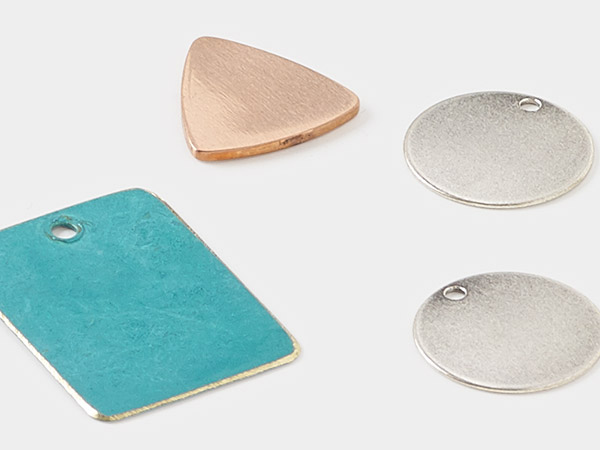A Guide to Metals
The materials in a piece of jewelry carry a message with them: socially, culturally and metaphysically. Does your jewelry say what it means, and mean what it says?
The Warm Gleam of Gold

Metals such as platinum or palladium may be worth more on the investment markets, but for jewelry, nothing speaks to the human heart more than the warm gleam of gold.
The value of gold is set by its fineness--the proportion of pure gold to other metals added for strength or durability. 24Kt is pure gold, 18Kt gold is 18 parts pure gold, 14Kt gold is 14 parts pure gold, etc. 10Kt is traditionally used for men's jewelry in the United States, and 14Kt for women's jewelry. In Europe, the gold standard for both men's and women's jewelry is 18Kt, which has a darker color with a deeper yellow tone. Gold components above 18Kt are frequently, albeit not always, hypoallergenic.
Colored golds are also available. Popularized by jewelry from the Great Plains (and commonly called "Black Hills Gold"), colors include rose gold (a blend of yellow gold and copper) and white gold (a blend of yellow gold and a white metal such as platinum, palladium or nickel). However, if you see some jewelry made from Black Hills Gold, you can be sure that it was made in the Black Hills of South Dakota, USA. (That's regulated by law!)
In addition, Art Clay® gold clay is created from 22Kt gold powder. Mold it, shape it and fire it in a kiln to create precious gold jewelry.
Wearing gold jewelry conveys a message of classic style, luxury and tradition. Gold adds a warmth and richness to your jewelry and an heirloom quality to pieces made with it. Metaphysically, gold is believed to symbolize spiritual purity, combat depression, bolster emotional stability and reduce feelings of inferiority. Gold is used to open and activate the crown and third-eye chakras. It is affiliated with the Zodiac sign of Leo.
| Karat Measure Chart | |
| Karat Measure | Gold/Alloy Content |
| 24Kt | 100% pure gold |
| 18Kt | 75% pure gold - 750 |
| 14Kt | 58% pure gold - 580 |
| 10Kt | 42% pure gold - 420 |
| 9Kt | 37.5% gold - 375 |
Gold-filled items are basically gold "sandwiches." Imagine covering a slab of base metal (usually brass) with a gold-alloy spread. Then that "sandwich" is either rolled up or squeezed sideways through an opening to create an item of the desired thickness and shape. Gold-filled items are very durable and most people don't have allergic reactions to them. It's a way to gain the glories of gold at a lower price.
We carry 14Kt and 12Kt gold-filled items but sometimes the difference is not obvious as to what that means so here is the technical explanation:
Gold-filled items must have 1/20th or 5% GOLD by weight to be called gold-filled. You may see it noted or stamped on pieces as 12/20 GF (5% of 12Kt Gold by weight) or 14/20 GF (meaning 5% of 14Kt gold by weight). 12kt and 14kt refer to the purity of the gold. Gold-filled is a layer of 5% karat gold over a core of jewelers brass typically.
Gold is measured on a scale of 1 to 24 with 24 being the purest gold. The scale is a gold to metal ratio. In order to make the gold stronger it is alloyed with other metals to achieve 18kt / 14kt / 12kt / 10kt. If 24kt is the purest – 12kt is half of 24 or 50% purity of 24kt gold. 14kt gold is 58.3%
There are benefits to using gold-filled besides cost, however. As other metals are added the gold is reinforced. 24kt gold is very soft whereas 14kt, which is typically used in US wedding rings, is very strong and can take the daily wear and tear. The color will also vary slightly as 24kt gold is very yellow and it turns lighter and more golden as other metal is added. Furthermore, the purer the gold the slower the piece will tarnish.
Gold-plated and gold-finished items are simply products of a base metal wearing a coating of gold--the thickness of the gold coating determines what it legally can be called. Any item called "gold-plated" has to be covered with a layer of gold that is .15 to .25 mils of gold. Gold-finished items are electroplated with a layer of gold that has no standards at all. The thickness of the gold plating on an item can either let the base metal show through or conceal the color of the base metal entirely--like the difference between a bridal veil and a trench coat.
Vermeil beads and findings are also gold-plated but, instead of being made of a base metal such as brass, they're formed out of sterling silver. Plating richness varies on vermeil items--they can be heavily electroplated with 18Kt to 22Kt yellow gold.
The Cool Glimmer of Silver
The cool glimmer of silver has, in the western world, traditionally been linked to the moon and, thus, to women. It carries with it a sense of mystery, of hand-crafted and ethnic styles. Because of its easy availability and lower cost, silver has more often been chosen as the leading metal in jewelry fashion--allowing silversmiths the freedom to experiment with new and innovative designs or to revive ancient skills.
Metaphysically, silver is believed to improve speaking skills, ease pain in the reproductive system, provide insight without judgment (especially self-insight) and mirror energies back to their sources. Silver is used in the crown chakra. It is affiliated with the Zodiac signs of Cancer and Aquarius, as well as any sign under the influence of the moon.
Fine silver is the highest and most pure type of silver available: 99.9% silver. This pure form of silver is used by the Hill Tribes of Thailand to create beads, chains and findings. In addition, Art Clay® is created from the fine silver particles reclaimed from recycled film, and can be used to create jewelry of fine silver.
Sterling silver items are made of 92.5% pure silver and 7.5% copper or some other metal (or metals). Those proportions are set by law--change the proportions and those beads aren't sterling silver. A clue that you've got sterling silver beads? Over time, sterling silver will take on an antiqued look (called a "patina"). Most of the precious silver you'll see in the beading world is sterling silver. (View quick tips for telling the difference between fine silver and sterling silver.)
Sterling silver-filled items are an alternative to fine and sterling silver components, with selections including beads, pendants, jump rings, ear wires and more. These pieces are manufactured with an outer layer of sterling silver (.925/20) over a copper-alloy core. The findings have additional silver plating for uniformity. Sterling silver-filled items are also usually finished with an anti-tarnish coating.
Argentium® silver is a form of sterling silver where some of the copper alloy is replaced by germanium. This creates tarnish resistance in the silver, without lowering the purity of the metal.
Nickel silver (sometimes called "German silver," "Alpaca silver" or "Mexican silver") is made of a blend of metals--mostly nickel--and looks much like sterling silver. Side-by-side comparisons show that nickel silver has a slightly greyer color tone. This metal offers the look of silver without the price while being easy to solder and resistant to corrosion and tarnish. Nickel-plated items are also available. Note that metal-sensitive jewelry wearers should avoid this material.
| Common Types of Silver | |
| Fine silver | 99.9% silver, 0.1% other metals |
| Britannia silver | 95.84% silver, 4.16% other metals (usually copper) |
| Sterling silver | 92.5% silver, 7.5% other metals (usually copper) |
| Argentium® silver | 92.5% silver, 6.4% other metals (usually copper), 1.1% germanium |
| Coin silver | 90% silver, 10% other metals |
| Nickel silver | 0% silver, 100% other metals (usually nickel, zinc and copper) |
The Beauty of Rose Gold
Rose gold is rising to new levels of popularity in jewelry with its subtle, romantic color of gold that adds a statement of femininity to designs. Many refer to this metal as a precious pink or soft champagne rose color. This beautiful blend of gold and copper is more durable and offers a different color interplay than either of its component metals: gold and copper. Rose gold makes us feel pretty and is highly sought after for modern jewelry designs and wedding rings.
According to Accessories Magazine, "Rose gold, a slightly pink hue of gold, is the perfect way to update a classic accessory in a chic, modern and trendy way." Some jewelry blogs have called rose gold "the most feminine gold." And indeed, its character is ultra-warm and soft, which lends itself to ultra-feminine fashions. Rose gold is universally flattering and brings out the subtle blush of the skin in both warm and cool skin tones, making it a perfect choice for jewelry designs.
History
Rose gold was first introduced in early 19th century Russia by the famed jeweler Carl Faberge in his Faberge eggs and it became known as Russian gold. Rose gold was enjoyed in the United States during the elegant 1920s and Cartier famously brought this metal back into the spotlight more recently with its Trinity Ring, a simple band of three gold colors.
Designing With Rose Gold
Many credit the comeback of color in fashion to the current rise in demand of rose gold. Rose gold complements almost any outfit color and photographs well. Its warm color has become a go-to way of dressing up neutral and nude color fashions for a richly feminine result. Create an on-trend look by layering rose gold necklaces, rings and bracelets for a major impact.
Rose gold is a perfect compromise between yellow gold and white gold and mixes well with both, representing a balance between a traditional and modern look. Rose gold also pairs well with all types of gemstones and adds a vintage touch to engagement rings and jewelry.
Easily create rose gold pendant necklaces using rose gold-filled chains and your choice of charms or pendant. Incorporate rose gold-filled beads and findings into jewelry designs for a bright and sophisticated effect and let rose gold Crystal Passions® beads and rose gold seed beads take center stage for a beautiful statement.
Rose gold is well-loved for its versatility. Design with pink stones and accents for a tone-on-tone effect or use other colors such as blue, red, purple, white and brown gemstones for an eye-catching statement. Black gemstones, such as black onyx, make a striking contrast in jewelry. Take advantage of rose gold Accu-Flex® professional-quality beading wire and rose gold-filled wire for adding soft and feminine elements to designs.
Enjoy the beauty and warmth of rose gold in timeless jewelry designs that will make you feel pretty.
The Meanings of Other Metals
Aluminum (or aluminium) is a soft and lightweight metal, one of the first "modern" metals. Like gold, silver and copper, aluminum is a pure element. First identified in 1782, it was a luxury metal until 1889, when the Hall-Héroult electrolytic process made refining and alloying the metal far more affordable. Household and industrial use of aluminum has revealed its benefits: it is much lighter than equivalent metal of the same size. Aluminum can be dyed, coated and anodized (an electrical current is run through it, which makes the metal "self-coat" in a variety of colors, depending on level of current). This ability to be anodized into a range of colors has lifted aluminum's cachet and made it an appealing material for chainmaille and other metal-focused jewelry design work. It can be worked without tools. Practitioners of energy work believe aluminum is ideal for protection from attacks and negative energies.
Brass is an alloy composed of copper and zinc, popular for its bright, golden appearance, similar to bronze (an alloy of copper and tin that predates brass). Valued for its durability, brass offers the look of gold without the high price tag. It is often used as a base for gold-filled, gold-plated, and gold-washed items, providing an economic alternative to pure gold. Alloys with higher percentages of copper have been referred to as "red brass" or "red bronze" in the metals trade.
Culturally and stylistically, brass with a patina has taken on a recent connotation for jewelry makers: it is one of the three metals of Victoriana and, most importantly, steampunk. (The others are iron and copper.) Brass is believed to combine the metaphysical abilities of copper and zinc, making it useful for boosting the immune system and clearing out old spiritual debris.
Bronze is an alloy of copper and tin used for tools and armor during the Bronze Age. It was highly popular in classical Greece and Rome for statuary, a tradition revived in the Italian Renaissance and still active today. Over 160 bronze statues stand in the city of Washington, D.C., such as the statue of Thomas Jefferson in the Jefferson Memorial. Using bronze findings, wire and clay can make a beautiful addition to jewelry designs. Metaphysically, bronze is believed to enhance courage, increase practicality and improve focus.
Copper was the first metal to be worked by human hands. Soft and very malleable, it is an element in and of itself (Cu), much like gold and silver. Copper is commonly used in alloys such as brass, bronze, sterling silver, rose gold and more. The metal displays a range of patinas, sometimes determined by the nature of the other metals in its alloy. Copper is believed to promote energy, stimulate initiative and conduct body energy around the body. It is assigned to the base and sacral chakras and affiliated with the Zodiac signs of Taurus and Sagittarius.
Jeweler's Bronze was designed by jewelers to look like high karat gold, without the price tag. This alloy (also called Tombac) is predominately copper with a low amount of zinc--which means it's actually a form of brass. Jeweler's bronze is easy to work; it easily cuts with shears and can be embossed by hand or via machine. Metaphysically, jeweler's bronze is a brass.
Rhodium plating can sometimes appear in jewelry and in jewelry components as a whiteness protectant or as an anti-tarnish coating. Some jewelry wearers are sensitive to this metal. Rhodium-plating draws on the imagery of silver--of coolness and sleekness--and gives a high-end glossiness to economy pieces.
Pewter is one of the oldest alloys in the history of metal working and has a long and noble history, from ancient Rome to the modern Academy Awards, where the world famous Oscar® statuette is cast from lead-free pewter. Pewter holds tiny details well and can be used to create themed jewelry at an affordable price.
High-Tech Metal
These days, advances in technology and manufacturing have expanded your choices of metals for jewelry: stainless steel, niobium and titanium.
Stainless steel is a generic word for any steel that contains more than 10% chromium (it can also have other metals in it like nickel, niobium or titanium). It resists rust and is easy to keep looking fresh and new. Stainless steel components tend to retain their shapes. There are different grades of stainless steel, defined by the properties of the alloy mixed in-- especially the nickel content:
- Steel that is 304 and 304L grade has a nickel content around 8 to 12%.
- Steel that is 316 and 316L is made with more resistance to corrosion. These grades have a nickel content of about 8 to 10.5%. The 316L version of stainless steel has less carbon than 316 to provide even higher resistance to corrosion.
Stainless steel comes in a multitude of finishes: sleek and gleaming, to brushed and satiny to rough and textured. However, stainless steel still gives an idea of modernism, technology, futuristic design and lets your jewelry look up-to-the-minute. Interestingly, stainless steel jewelry supplies work great for creating or repairing retro '50s and '60s fashions!
Niobium is one of the benefits of advances in chemistry. Since niobium metal is stable and hypoallergenic, it's used in all sorts of industrial and medical uses. You can find niobium components in jet engines, particle accelerators and space rockets, as well as pacemakers and jewelry!
Niobium comes in a multitude of anodized colors, without using dyes, which makes it great for jewelry designers.
Niobium adds great color unity to jewelry. You can make jewelry that is completely purple. Or blue. Or green. And not have to worry about using lightweight plastic pieces for color.
Titanium is the ultra high-tech, newest of the new metals. It is a super-strong and corrosion resistant metal: pure titanium is as strong as the same amount of steel but is 45% lighter! Plus, it is almost as resistant to corrosion as pure platinum. While most titanium ends up as a white colorant (used in paint, paper and plastic), it's also used in gemstones, horseshoes and replacement joints.
Because of its durability and light weight, naturally grey titanium has grown into a popular metal for designer jewelry. Like niobium, titanium can be anodized into colors. While titanium is not considered hypoallergenic, most people with metal sensitivities can wear it safely.
When you design jewelry, you're not only creating beauty, you're creating a message. That message is a mix of the design, the colors, the techniques--and the materials.
What do your jewelry designs say?
Shop for Your Materials Here:
Have a question regarding this project? Email Customer Service.
Copyright Permissions
All works of authorship (articles, videos, tutorials and other creative works) are from the Fire Mountain Gems and Beads® Collection, and permission to copy is granted for non-commercial educational purposes only. All other reproduction requires written permission. For more information, please email copyrightpermission@firemtn.com.
**Please note that all metaphysical or healing properties listed are collected from various sources. This information is offered as a service and not meant to treat medical conditions. Fire Mountain Gems and Beads® does not guarantee the validity of any of these statements.
